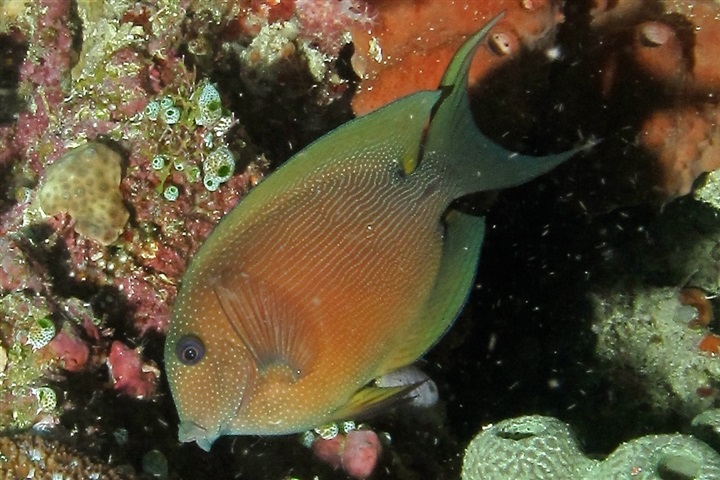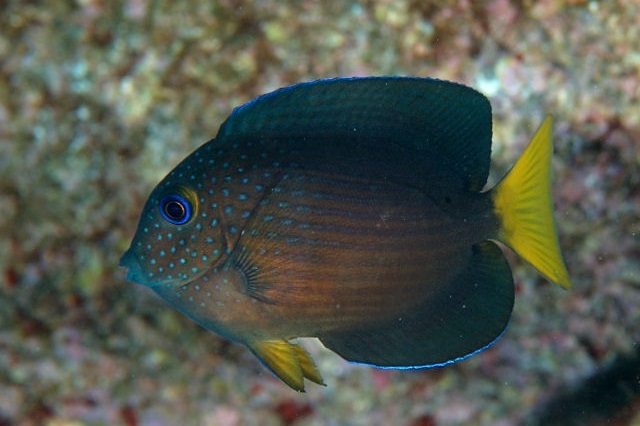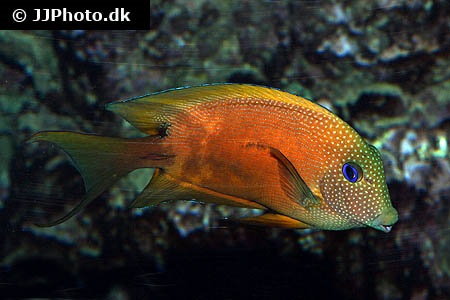Ctenochaetus binotatus
| Latin name | Ctenochaetus binotatus - Randall, 1955 |
|---|---|
| Local name | Twospot surgeonfish |
| Family | Acanthuridae - Ctenochaetus |
| Origin | East Indian Ocean, West Indian Ocean, Australia, Indonesia, Central/West Pacific |
| Max length | 22 cm (8.7") |
| Minimum volume |
500 l (132 gal) |
|---|---|
| Hardiness |
Average |
| Suitable for aquarium |
Suitable with care |
| Reef safe |
Always reef safe |
| Aggressiveness | Mostly peaceful but might be aggressive towards similar species |
| Recommended |
Macroalgea (Eg. seaweed / nori) Microalgea (Eg. spirulina) |
|---|---|
| Mostly |
Detritus Small crustaceans (Krill, mysis, artemia...) |
These fish should be kept in a well run aquarium where they can "graze" algae from rocks and stones.
If there are insufficient algae on the rocks, it is important to feed more frequently and supplement with algae rich food e.g. Spirulina.
This species needs good hiding places, for example, between live rocks.
This species revels in swimming and requires an aquarium with ample space.
Even though these fish enjoy a diverse type of frozen foods, it is imperative that its primary food, is algae based, thus ensuring that the fish`s immune system remains healthy.
This can, for example, be plant based fish flakes, Nori seaweed or similar.
This species has a yellow tale as juvenile while it is brown with adults.
The genus Bristletooth Tang (Ctenochaetus) contains a range of species, which are characterized by special teeth.
Like other Surgeonfish the Bristletooth Tang eats algae but with their specialized teeth they also scrape other organic material from rocks and stones. Ample sand and rocks are therefore imperative.
Overall the Ctenochaetus are peaceful and not quite as active, as many of the other surgeonfish. It is therefore suited to smaller aquaria.
Because of these their mild behaviour they are not a good combination with some of the more aggressive Surgeonfish.
Ctenochaetus are not so colourful as many other Surgeonfish. Some species are more vibrant in colour but this changes when they get to around 3 inch (7-8 cm).
Surgeonfish (Acanthuridae) live primarily of different types of algae, making it a popular choice for coral aquariums, as they help to keep the aquarium algae free.
Most Surgeonfish have a scalpel by the caudal fin, used to defend themselves. It can cause some deep lacerations, so pay attention if the fish start to fight and when handling the fish.
When in the aquarium, they will spend most of their time swimming around and nibbling the algae from the stones. Surgeonfish will rarely irritate corals or invertebrates. Large Palettes/Blue tangs can be an exception.
The Surgeonfish are not typically aggressive towards other types of fish. If more Surgeonfish are added to the aquarium, they will establish a hierarchy. It is best to add the most aggressive species last and to ensure that there are sufficient hiding places, as they prefer to have their own individual sleeping area.
If multiple aggressive species are added to the same aquarium, one runs the risk of one of them dying due to stress. One must therefore be cautious about adding multiple Acanthurus species or Zebrasoma xanthurum into the same aquarium. A combination of the different genera will normally get along well, although the more aggressive species can still be challenging.
| Aquarium trade | Yes |
|---|---|
| Distribution | Indo-Pacific: East Africa to the Tuamoto Islands, north to southern Japan, south to central New South Wales (Australia) and New Caledonia. Not known from the Red Sea, Gulf of Oman, the Gulf, the Hawaiian Islands, Marquesas, Rapa, Pitcairn Islands, and E |
| English common names |
Two-spot bristletooth Twospot bristletooth Two-spot bristle-tooth Twospot surgeonfish |
| Danish common names |
Toplettet kirurgfisk |
| German common names |
Blauaugen-Borstenzahn-Doktorfisch |
Henry C. Schultz. 2003. Is it a Comb or a Bristle (Surgeonfish)? The Genus Ctenochaetus - Reefkeeping Magazine - (English)
Bob Fenner. The "Bristle-Tooth" Surgeonfishes, Genus Ctenochaetus - Wet Web Media - (English)
James W. Fatherree. 2009. Aquarium Fish: Surgeonfishes, A.K.A. the Tangs - Advanced Aquarist - (English)
Bob Fenner. Surgeons, Tangs and Doctorfishes, Family Acanthuridae - Wet Web Media - (English)
2013. Kirurgfisk - Saltvandswiki - (Danish)




